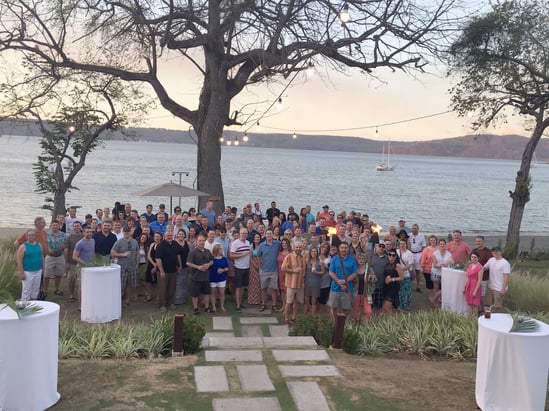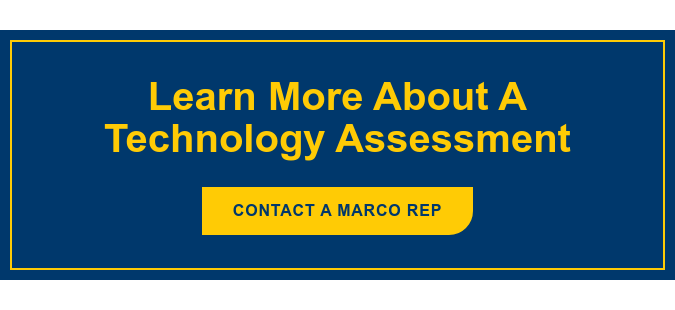As I walked with the Marco team into the airport to return home from a recent trip to Costa Rica, my first thought was, “There has to be a better way.”
Some passengers walked straight to the ticketing counter before realizing that they had to find the “guy” to pay their exit tax to, and yes it was one guy. This all ensued as the security officers stood by patiently with no one in their line waiting for what soon would be an onslaught of passengers going through.
 People leaving the line from the one guy collecting the exit fee soon overwhelmed the ticketing area. It was a clear bottleneck that led some passengers to circumvent the process altogether. It didn’t help that our team alone arrived in two buses and flooded the area with about 100 people at once.
People leaving the line from the one guy collecting the exit fee soon overwhelmed the ticketing area. It was a clear bottleneck that led some passengers to circumvent the process altogether. It didn’t help that our team alone arrived in two buses and flooded the area with about 100 people at once.
As I waited, I unraveled the process.
I started with arrival: “What if they staggered the departure of our buses from the hotel, one leaving 15 or even 30 minutes later than the first?” I thought. “How many exit fee collectors do they really need?” My mind rolled with questions as I stepped through the process.
WHAT I LEARNED IS THIS…
- Continuous improvement really is a continuous mindset.
One of my greatest takeaways from our company’s weeklong trip was the mindset of our members. Whether we were checking in at our hotel, taking part in an excursion or waiting in line at the airport, the same phrase kept coming up from our team members, “This is a good opportunity for a Kaizen.”
At Marco we use the LEAN process for continuous improvement, which includes hosting Kaizen events to streamline existing processes. Through Kaizen events, a small group of employees conducts a deep dive into a specific process in our organization over three days and develops a solution.
We’d smile or chuckle and move on. As I heard it more and more, I realized the intentional employee training that we do to teach our employees to look for opportunities for continuous improvement is working – even when they’re on vacation. Are you continuously seeing opportunities to improve?
- You can have a great process, but if it is not evident to the customer, it doesn’t matter.
Sometimes, when our first thought is “This is an opportunity for a Kaizen,” we learn that the process is actually solid. The problem is that not everyone knows what it is.
Those who have left Costa Rica in the past, knew about paying the exit tax to receive the authorization to be checked in for the flight. Many didn’t. What if they had signs directing people through the process?
We benefit when we look at our processes from an outsider perspective and consider how we can communicate the steps. How can you make your processes more evident to outsiders? - Standardizing work really does make a difference.
We talk a lot about “standard work” at Marco – starting at new hire orientation when we train our team members to have a continuous improvement mindset.
During a training exercise, we ask employees to perform a task that they have not done before as a small group. (You may want to try this yourself). We give team members a box of unorganized picnic materials, including seven place settings that are exactly the same, non-matching picnic items and other miscellaneous items.
Then, we ask the first group to set a table for six – and we time them. Next, we straighten and sort the items and have a second group perform the activity. The results are better, but not where we want them to be. So, a final group performs the task as “standard work.” Standard work is a simple written description of the safest, highest quality and most efficient way known to do a particular job - as of today.
They complete the task in significantly less time with fewer people, lower stress and higher quality – every time. Mapping out the process and determining the best workflow is powerful. What can you standardize? - Reducing waste creates a win-win for you and your customers.
Continuous improvement centers around creating a more efficient and effective process, and specifically identifying areas of waste. Those often include transportation, inventory, motion, waiting, over-processing, over-producing or defects. Motion, for example, involves any unnecessary movement that does not add value to the product or service.
Waste in inventory, production and defects are where organizations focus much of their time. Yet waiting and motion provide some of the best opportunities.
Reducing waste in wait is often where technology comes in for the win. I saw it firsthand as a customer on my trip home. While on the plane, I was pleasantly surprised when the flight attendants did not hand out paper customs forms. The process of navigating the tiny print, how to order the date (Does the month or day go first?) and checkboxes can be stressful. It usually leads me to ask for a second form to get it right, or kindly ask my wife to tackle it.
In Minneapolis, customs replaced those paper forms with easy-to-use self-serve kiosks. I answered questions with a few taps on the screen. It took my picture and printed a receipt. It felt stress-free, faster and more accurate. Where are opportunities to reduce waste?
We have exceptional continuous improvement specialists on staff (Tina Hengel and Scott Roeder) in addition to a Continuous Improvement Steering Committee that includes our entire executive team. But what makes us successful is the continuous improvement mindset of all our team members. We continue to challenge ourselves to look for opportunities and ask “How can we do this better?”

